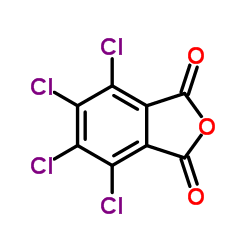Assessment of risk factors for IgE-mediated sensitization to tetrachlorophthalic anhydride.
G M Liss, D Bernstein, L Genesove, J O Roos, J Lim
Index: J. Allergy Clin. Immunol. 92(2) , 237-47, (1993)
Full Text: HTML
Abstract
Two groups of workers with occupational asthma caused by tetrachlorophthalic anhydride (TCPA) have been reported on; in only one report was specific anti-TCPA antibody demonstrated. We received a request to investigate respiratory problems among workers at a plant where solenoid coils are manufactured with the use of epoxy resin and where a new TCPA hardener had been introduced in 1988. In response, we conducted a cross-sectional evaluation of 52 current workers and assayed serum samples from 49 workers for TCPA-human serum albumin-specific IgE and IgG by ELISA. Mean airborne TCPA concentrations ranged from 0.21 to 0.39 mg/m3 in 1989 and May 1990 but were considerably lower (less than 0.009 to 0.13 mg/m3) by July 1990 when ventilation was introduced. Workers were classified in four departments as molders (most directly working with TCPA), those intermittently exposed to TCPA, coil assemblers, and office workers. There was a high prevalence of reported work-related respiratory symptoms (from 27% to 39%). The mean decline in FEV1 over the shift in the molders (down 4.1%) was significantly different from the change in the office group (increased 2.5%). Intrashift change in FEV1 was inversely correlated with log personal TCPA concentration (r = -0.47). Of 49 current workers, 15 (31%) had elevated serum TCPA-human serum albumin-specific IgE antibody levels and 19 (39%) had elevated specific IgG levels. The prevalence of specific IgE was highest in the mold and intermittent groups (54%), in comparison with the coil assembly (25%) and office (0%) groups. Those workers who were IgE positive were significantly less likely to be current smokers and had worked significantly longer since 1988. Of those hired in 1988 or after, the proportion of workers who were IgE positive increased with duration of employment category (p value for trend 0.022). Since ventilation was installed and TCPA exposures reduced to less than 0.1 mg/m3, there has been a marked decrease in symptoms and no new cases of occupational asthma among newly hired workers at the plant.
Related Compounds
| Structure | Name/CAS No. | Molecular Formula | Articles |
|---|---|---|---|
 |
Tetrachlorophthalic anhydride
CAS:117-08-8 |
C8Cl4O3 |
|
Allergic reactions to industrial chemicals.
1983-01-01 [Clin. Immunol. Rev. 2(1) , 1-58, (1983)] |
|
Acid anhydrides.
1991-01-01 [Clin. Exp. Allergy 21 Suppl 1 , 234-40, (1991)] |
|
Immunologic specificity of IgG against trimellityl-human ser...
1993-06-01 [J. Lab. Clin. Med. 121(6) , 792-6, (1993)] |
|
Tetrachlorophthalic anhydride asthma: evidence for specific ...
1983-01-01 [J. Allergy Clin. Immunol. 71(1 Pt 1) , 5-11, (1983)] |
|
Interaction of smoking and atopy in producing specific IgE a...
1985-01-19 [Br. Med. J. (Clin. Res. Ed.) 290(6463) , 201-4, (1985)] |